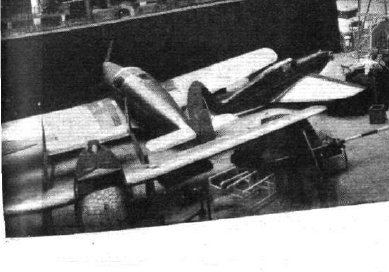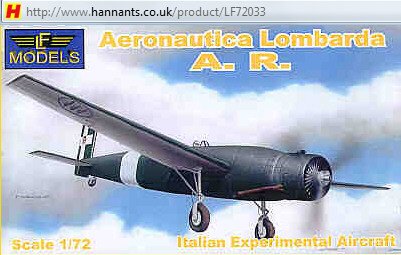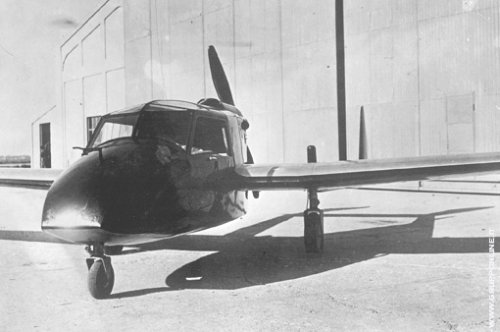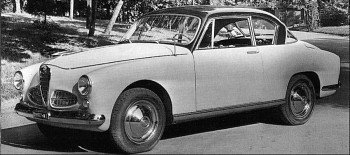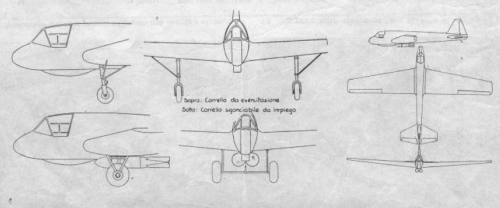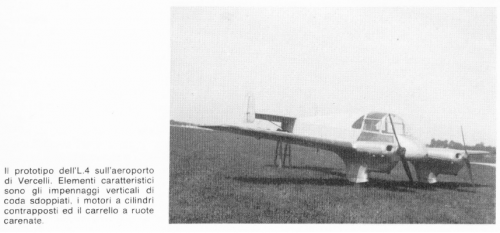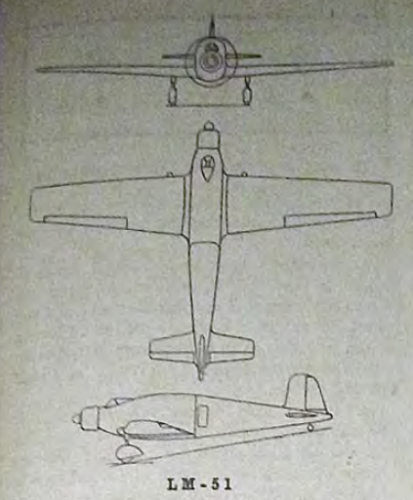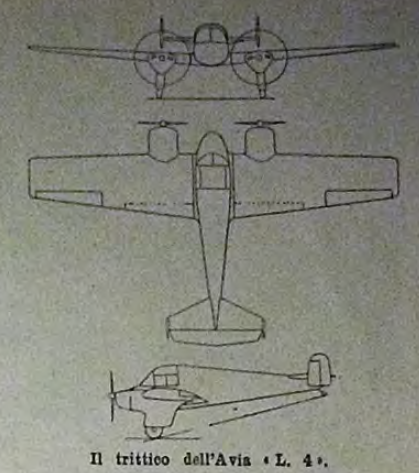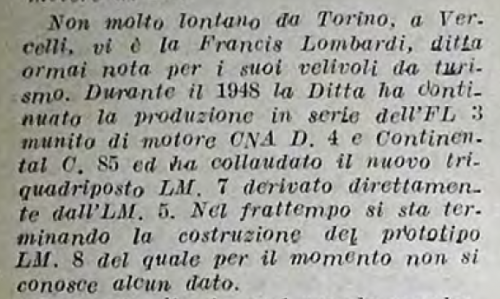I hope to make a small list to it.
That would be most useful. The Lombardi corporate lineage is a bit convoluted but here's what I've cobbled together so far ...
'Francis' Lombardi formed A.V.I.A. in Vercelli in 1938. That firm was formed as Anonima Vercellese Industria Aeronautica - meaning its stock was privately traded. When it became publicly-traded, the firm's name was changed to Azionaria Vercellese Industrie Aeronautiche - or the Aeronautical Industries Stockholdings of Vercelli (
azoni being stocks under Italian law).
In 1945, A.V.I.A. resumed FL.3 production (which had been interrupted in 1940). They also built a single FL.3C prototype (with new, slotted wings) and a twin-engined L.4 prototype while producing the LM.5
Aviastar in a small series. The LM.7 airframe reached the static testing stage.
As said before, in 1947 the corporate name changed to the more generic Francis Lombardi & Cie - to reflect a broadening of industrial interests beyond aviation. This was realized in the same year with the formation of the Carrozzeria Francis Lombardi (1947-1973) [1]
In March of 1947, another firm was established 500 km to the east near Trieste - Furio Lauri's Meteor S.p.A. Costruzioni Aeronautiche - as an aircraft repair and salvage business. [2] The first products were 'scrap' Taylorcraft
Auster AOPs and Fairchild UC-61K
Forwarders which were salvaged and restored. Although technically illegal there was nothing particularly covert about Meteor's rebuilds. That said, no designations seem to have been applied to the
Austers and 'F-24Rs'.
Meteor S.p.A. went on to produce gliders under licence - initially for the Aeronautica Militare. These were given 'MS' designations ... but that 'S' stood for two different designers. The MS.18
Falco and MS.21
Gabbiano high-performance sailplanes were by the Swiss engineer Jakob Spalinger. The MS.30 L-
Passero training glider was by the German engineer Egon Scheibe.
Meteor S.p.A. MS.18 - Single-seat performance sailplane; span 14.30 m
- MS.18: Unbraced, shallow gull wings; based on Spalinger's S 18
Meteor S.p.A. MS.21 - Performance sailplane; span 17.30 or 17.50 m
- MS.21: Braced gull wings; based on Jakob Spalinger's S 21 design*
-- * Exact model licenced would determine seating arrangements
Meteor SpA MS.30 - Single-seat performance sailplane; span 15.00 m
- MS.30 : L-
Passero (Sparrow; translating from German); [3] x 16
- MS.30 : Based on Scheibe Flugzeugbau's L-
Spatz 55 design*
-- 'L' seems to be retained from German
Leistung (Performance)
In 1953, Meteor S.p.A. acquired the aviation assets of Francis Lombardi & Cie - including rights to the FL.3 light cabin aircraft. The object was to allow Meteor to pursue powered aircraft development. Meteor S.p.A. later went on to develop a range of
Alpha light aero-engines, drones, and missiles but the aircraft relevant to the Lombardi purchase were:
Meteor S.p.A. FL.53: 1953 FL.3 devel., 2-seat trainer and tourer
- FL.53 : 1 x 65 hp Continental A65 HO4 engine; span 9.85 m; x 8
- FL.53 : Wooden wings; welded steel-tube fuselage construction
- FL.53BM: 1 x 90 hp Continental C90-12F HO4 engine; 4 x built
-- FL.53 differed from FL.3 mainly in its cut-down rear fuselage
Meteor S.p.A. FL.54: 3-seat development of FL.53/FL.53BM; x 10
- FL.54: 1 x Continental HO4 (85 hp C85 or 90 hp C90 offered)*
-- * Some sources say 135 hp; prob. confusion with FL.55 (
qv)
Meteor S.p.A. FL.55: Strengthened 4-seat FL.54 derivative; x 4
- FL.55: 1 x 135 hp Lycoming O-290-3 HO4 engine; span 9.85 m
- FL.55B : 'Mountain Rescue Meteor' on skis for Switzerland; x 4
- FL.55BM: Mod. fin/rudder; 1 x 150 hp Lycoming O-320-A1A; x 10
-- FL.55 '
Abricolo': FL.55BM with wind-generator crop spraying rig
- FL.55CM: As per FL.55BM but 180 hp Lycoming O-360-A1A; x 1
-
Super: FL.55 fitted with a higher-powered Meteor engine; x 1
-
Super: 1 x 220 hp Meteor
Alpha 4 engine; span 9.85 m
-
Bis : 2-seat
Super variant with 110 hp Meteor
Alpha 2
In November 1981 Aeritalia bought a 50% stake in Meteor S.p.A. and by March 1983 the Fiume firm was a full subsidiary of Finmeccanica. In 1985 Meteor S.p.A. was rebranded as the rather generic Società Iniziative Industriali Italiane (or '3I'). After the 1990 Aeritalia-Selenia merger, 3I fell under Alenia. In 1992, the 3I
Sky Arrow lightplane was flown. But, by 2008, the Società Iniziative Industriali Italiane had entered bankruptcy proceedings.
________________________________________
[1]
https://www.carrozzieri-italiani.com/dealers/francis-lombardi/
[2] Meteor S.p.A.'s assembly hangar and offices were actually at Ronchi dei Legionari - the former airfield location of Cantieri riuniti dell'Adriatico outside of Trieste which Meteor leased from the government for 20 years.
When forming the firm, former
Tenente Colonello Lauri had just left the Aeronautica Militare. Previously, Lauri had scored 11 confirmed kills as a fighter pilot with the Regia Aeronautica then Co-Belligerent Air Force.
[3] As noted, Meteor S.p.A. simply added an 'M' to existing Jakob Spalinger designations - explaining the MS.18 and MS.21. The MS.30 designations is harder to explain. Scheibe Flugzeugbau referred to this sailplane as the L-
Spatz 55. Perhaps the FL-55 lightplane was already a gleam in the eye of Meteor S.p.A. and they wanted to hold that '55' number? Who knows?



